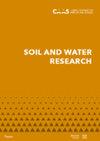不同休耕时间对土壤团聚体结构和腐殖质状态参数的影响
IF 1.7
4区 农林科学
Q4 SOIL SCIENCE
引用次数: 17
摘要
土壤团聚体结构和土壤有机质密切相关,通常被认为是土壤质量的关键指标。本研究旨在评估不同休耕时间对土壤结构指标和腐殖质状况指标的影响。对废弃农田进行了研究(废弃后15年、20年和35年)。作为参考地点,我们使用了该地区的一块耕地。试验土壤被划分为Gleyic Cambisol。用筛网(干筛)将土壤大团聚体分离为7个团聚体粒级,即>10、10-5、5-2、2-1、1-0.5、0.5-0.25和<0.25mm。土壤腐殖质状态参数包括以下指标:土壤有机碳(Corg)、腐殖质储量(QH)、有机质腐殖化程度(SOMdh),腐殖酸(HA)(游离并与单价阳离子和Al2O3、Fe2O3结合,与形成腐殖酸盐的Са2+结合,与粘土矿物结合)、黄腐酸(FA)(游离侵蚀性)和HA与FA的比率(CHA:CFA)。经过20多年的休耕期,地表形成了草皮层。长期休耕期对骨料的平均重量直径(MWD)和具有农业价值的骨料(AVA)有影响。落叶土壤的结构比耕地下的土壤要好得多。长期种植会导致土壤结构恶化,形成大团聚体(>10mm)。当土壤休耕不到15年时,Corg含量保持在背景含量的水平,并随着时间的推移而增加。在休耕35年的耕地上,0–20 cm土层上部的Corg从3.55%增加到8.74%,这在很大程度上与植物根系中有机质的大量积累有关。与可耕地类似物相比,成熟场地的特征是腐殖质成分中的黄腐酸增加。放弃土壤农业用途和停止机械耕作可恢复土壤的自然结构并改善其农业物理特性。这种研究以前从未在俄罗斯远东的普里莫尔斯基地区进行过。本文章由计算机程序翻译,如有差异,请以英文原文为准。
Impact of different fallow durations on soil aggregate structure and humus status parameters
Soil aggregate structure and soil organic matter are closely interrelated and commonly considered as key indicators of soil quality. The aim of this study was to evaluate the effects of different fallow durations on indices of soil structure and humus status indicators. Studies were conducted on abandoned agricultural fields (15, 20 and, 35 years after abandonment). As a reference site, we used a cultivated field in the area. The experimental soil fields are classified as Gleyic Cambisols. Soil macroaggregates were separated with the sieve (dry sieve) to seven aggregate size fractions, i.e.> 10, 10–5, 5–2, 2–1, 1–0.5, 0.5–0.25 and < 0.25 mm. The humus status parameters of soils included the following indicators: soil organic carbon (Corg), humus reserves (QH), the degree of humification of organic matter (SOMdh), fractions of humic acids (HA) (free and bound with monovalent cations and Al2O3, Fe2O3, bound with Са2+ which forms humates, bound with clay minerals), fulvic acids (FA) (free aggressive) and ratio of HA to FA (CHA : CFA). After a fallow period of more than 20 years on the surface formation of a sod layer. A long-term fallow period had an impact on the mean weight diameter of the aggregates (MWD) and agronomically valuable aggregates (AVA). Fallow soils have a significantly better structure than soils under a cultivated field. Long-term cultivation leads to the deterioration of soil structure and the formation of large aggregates (>10 mm). The Corg content remains at the level of the background content when the soils are left fallow for less than 15 years and increases over time. The Corg in the upper 0–20 cm soil layer has been shown to increase from 3.55 to 8.74% on arable land that has been fallow for 35 years and has been largely associated with significant accumulation of organic matter within the plant root mass. Mature sites are characterized by an increase of fulvic acids in the humus composition in comparison with their arable analogues. The abandonment of soil agricultural use and the cessation of mechanical tillage results in the restoration of the natural structure of soils and the improvement of their agrophysical properties. Such studies have not been previously conducted in the Primorsky region of the Russian Far East.
求助全文
通过发布文献求助,成功后即可免费获取论文全文。
去求助
来源期刊

Soil and Water Research
Water resources, Soil Science, Agriculture-WATER RESOURCES
CiteScore
4.60
自引率
0.00%
发文量
26
审稿时长
>12 weeks
期刊介绍:
An international peer-reviewed journal published under the auspices of the Czech Academy of Agricultural Sciences and financed by the Ministry of Agriculture of the Czech Republic. Published since 2006.
Thematic: original papers, short communications and critical reviews from all fields of science and engineering related to soil and water and their interactions in natural and man-modified landscapes, with a particular focus on agricultural land use. The fields encompassed include, but are not limited to, the basic and applied soil science, soil hydrology, irrigation and drainage of lands, hydrology, management and revitalisation of small water streams and small water reservoirs, including fishponds, soil erosion research and control, drought and flood control, wetland restoration and protection, surface and ground water protection in therms of their quantity and quality.
 求助内容:
求助内容: 应助结果提醒方式:
应助结果提醒方式:


